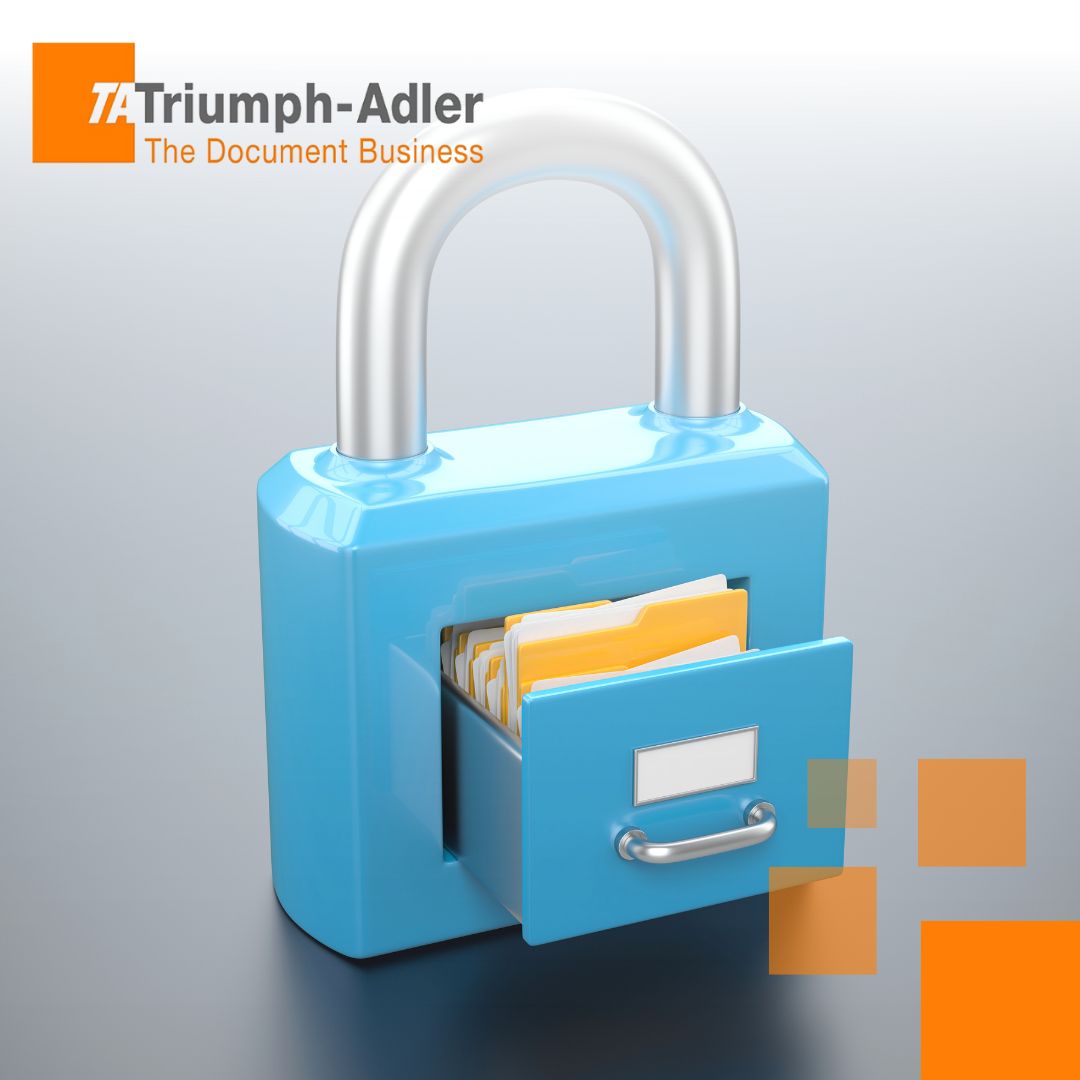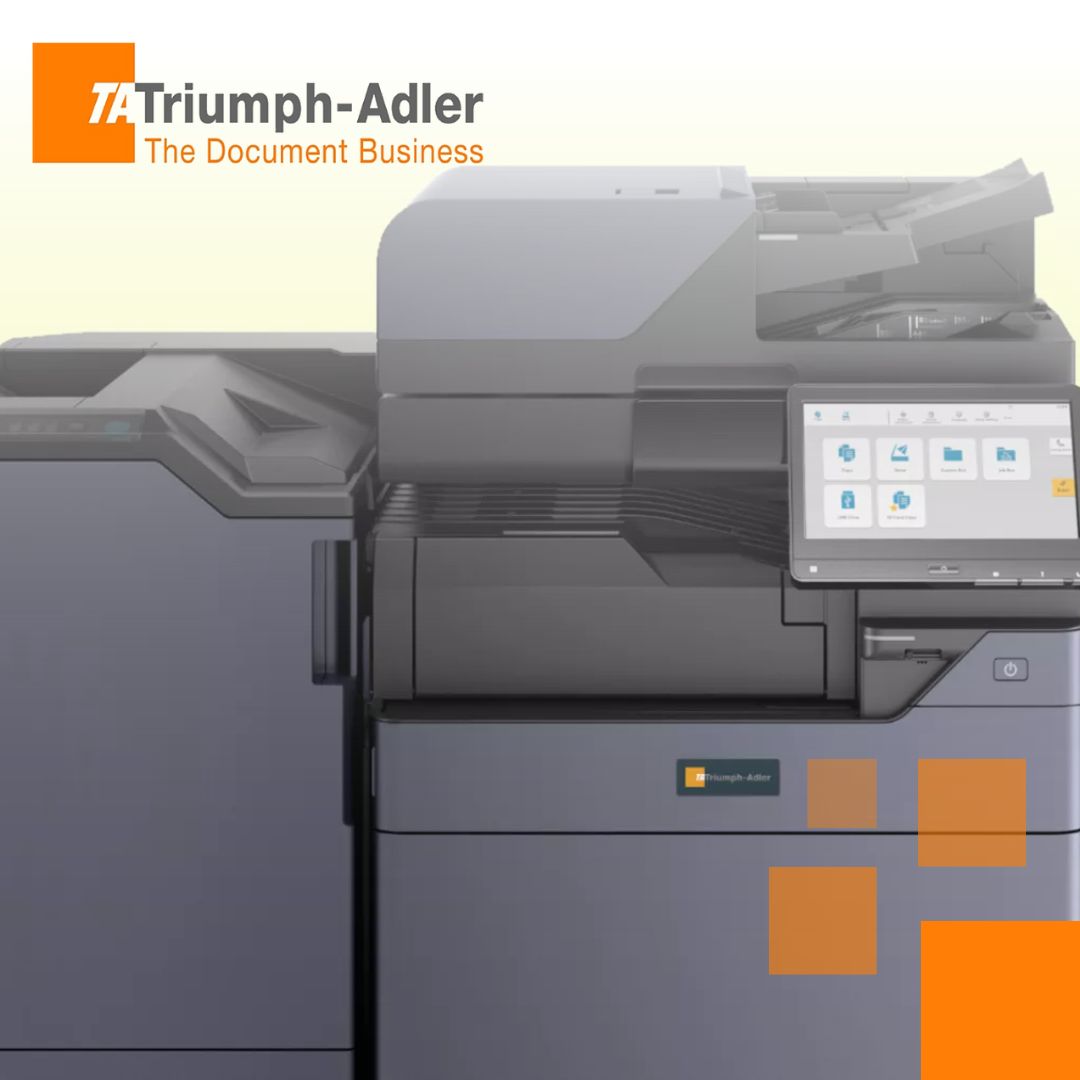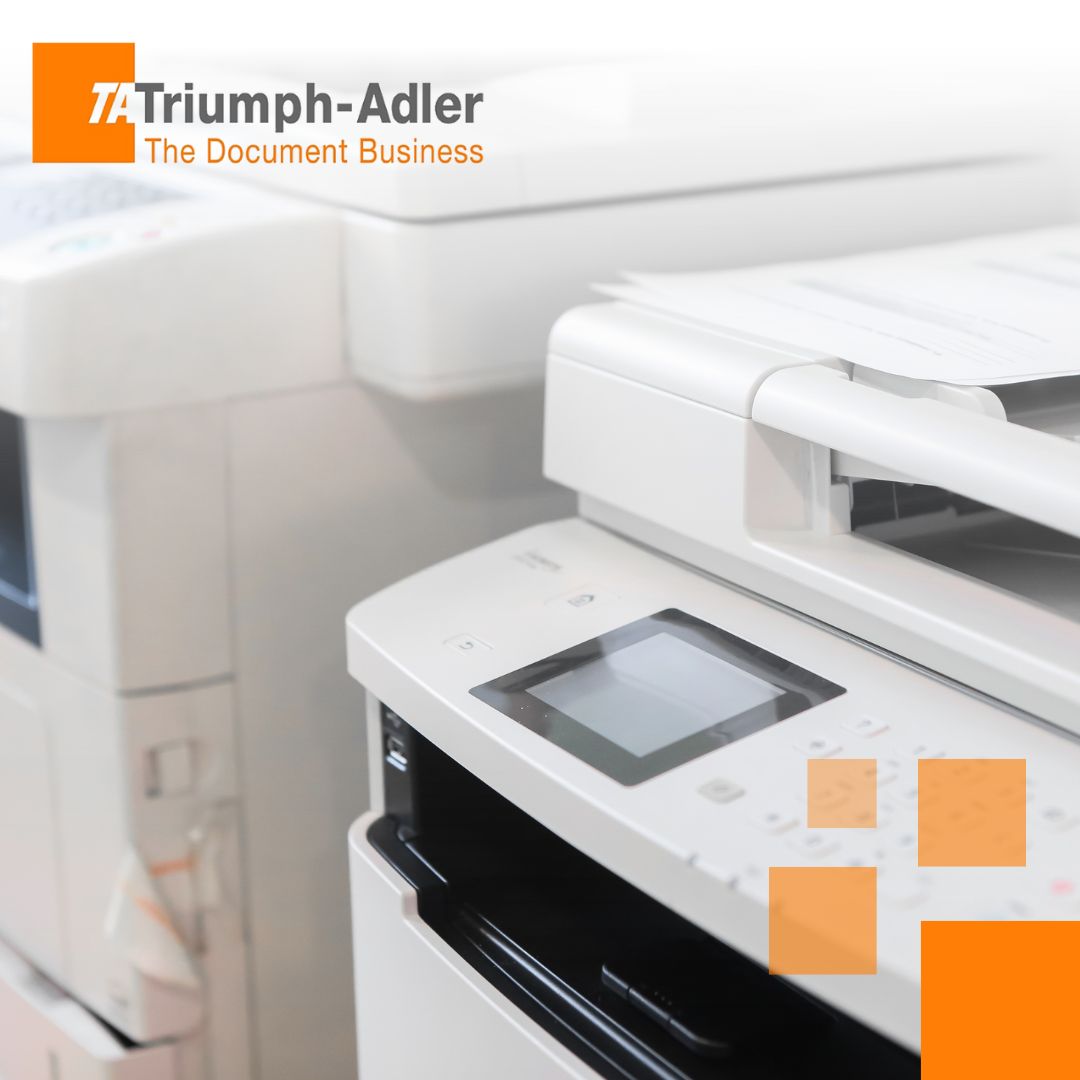Home | NEWS

Enhance Client Confidentiality Through Secure Document Management
In today's fast-paced digital age, financial institutions face the dual challenge of managing vast amounts of sensitive client data while ensuring its confidentiality and security. The financial sector, characterised by its reliance on trust and precision, must prioritise robust document management systems to safeguard client information and maintain the highest levels of confidentiality.
Triumph-Adler South Africa understands these unique challenges and offers state-of-the-art secure document management solutions tailored for financial institutions.
The Importance of Client Confidentiality in Financial Institutions
Client confidentiality is a cornerstone of the financial sector. Clients trust financial institutions with their personal and financial data, expecting it to be handled with the utmost care and discretion. Breaches of confidentiality can have severe consequences, including loss of client trust, legal repercussions, and financial losses. Therefore, implementing a secure document management system is not just a regulatory requirement but a business imperative.
Challenges in Document Management for Financial Institutions
Financial institutions handle a diverse range of documents daily, including account statements, loan agreements, investment records, and personal identification documents. Managing these documents effectively while ensuring their security presents several challenges:
-
Data Volume: The sheer volume of documents can be overwhelming, making it difficult to manage, store, and retrieve information efficiently.
-
Regulatory Compliance: Financial institutions must comply with stringent regulations regarding data protection and confidentiality, such as the Protection of Personal Information Act (POPIA) in South Africa.
-
Data Breaches: Cyber threats and data breaches are on the rise, posing significant risks to the security of sensitive client information.
-
Operational Efficiency: Efficient document management is crucial for smooth operations. Delays in accessing critical information can impact client service and decision-making processes.
Triumph-Adler's Secure Document Management Solutions
Triumph-Adler South Africa offers comprehensive document management solutions designed to address the specific needs of financial institutions. Our solutions ensure the highest levels of security, compliance, and operational efficiency, enabling financial institutions to focus on their core business activities.
1. Advanced Encryption and Security Features
Triumph-Adler's document management systems are equipped with advanced encryption technologies that protect data both in transit and at rest. This ensures that sensitive information is accessible only to authorised personnel, minimising the risk of unauthorised access and data breaches.
2. Regulatory Compliance
Our solutions are designed to help financial institutions comply with relevant data protection regulations, such as POPIA. Automated compliance features ensure that all documents are handled, stored, and disposed of in accordance with regulatory requirements, reducing the risk of non-compliance and associated penalties.
3. Access Control and Audit Trails
Triumph-Adler's document management systems provide robust access control mechanisms, allowing financial institutions to define and manage user permissions effectively. Detailed audit trails track all document access and modifications, providing a clear record of who accessed what information and when which is crucial for both security and compliance purposes.
4. Secure Cloud Storage
Our secure cloud storage solutions offer a scalable and cost-effective way to store and manage large volumes of documents. Financial institutions can benefit from enhanced data security, disaster recovery capabilities, and easy access to information from any location.
5. Document Digitisation and Automation
Triumph-Adler's document digitisation and automation solutions streamline document workflows, reducing manual processing and the associated risks of human error. Automated workflows ensure that documents are processed, reviewed, and approved efficiently, enhancing operational efficiency and reducing turnaround times.
Building Trust Through Secure Document Management
By implementing Triumph-Adler's secure document management solutions, financial institutions can significantly enhance client confidentiality and trust. Here are some key benefits:
-
Enhanced Client Trust: Clients are more likely to trust financial institutions that demonstrate a commitment to safeguarding their personal and financial information.
-
Reduced Risk of Data Breaches: Advanced security features and encryption technologies protect sensitive data from cyber threats and unauthorised access.
-
Improved Operational Efficiency: Streamlined document workflows and automated processes reduce delays, enhance productivity, and improve client service.
-
Regulatory Compliance: Automated compliance features ensure adherence to data protection regulations, reducing the risk of non-compliance and associated penalties.
-
Cost Savings: Efficient document management reduces the need for physical storage, minimises manual processing, and lowers the risk of costly data breaches.
Conclusion
In the financial sector, where client confidentiality and trust are paramount, implementing secure document management solutions is essential. Triumph-Adler South Africa offers comprehensive, secure, and compliant document management systems tailored to the unique needs of financial institutions.
By enhancing the security and efficiency of document management processes, financial institutions can protect sensitive client information, comply with regulatory requirements, and build lasting trust with their clients.
For more information on how Triumph-Adler South Africa can help your financial institution enhance client confidentiality and trust through secure document management, contact us today.

The Importance of Secure Document Management in Financial Institutions
In today's digital age, secure document management has become a cornerstone of operational efficiency and regulatory compliance in financial institutions. With the increasing volume of sensitive data being processed daily, financial institutions must prioritise the security of their document management systems.
This article explores the critical importance of secure document management in the financial sector, highlighting key benefits, challenges, and best practices.
The Critical Need for Secure Document Management
Protecting Sensitive Information
Financial institutions handle vast amounts of sensitive information, including personal identification details, financial statements, loan documents, and transaction records. The protection of this information is paramount to maintain client trust and comply with stringent regulatory requirements. Secure document management systems (DMS) ensure that sensitive data is stored, accessed, and shared in a controlled and protected manner.
Regulatory Compliance
Regulatory bodies worldwide have imposed stringent data protection regulations to safeguard consumer information. Financial institutions are subject to compliance with various laws in South Africa, as well as globally. Non-compliance can result in hefty fines and legal repercussions. A robust DMS helps institutions meet these regulatory requirements by ensuring proper data handling, storage, and retrieval processes.
Key Benefits of Secure Document Management
Enhanced Security
A secure DMS provides multiple layers of security, including encryption, access controls, and audit trails. Encryption ensures that data remains confidential, while access controls restrict document access to authorised personnel only. Audit trails track document activity, providing a transparent record of who accessed or modified a document and when. These features collectively mitigate the risk of data breaches and unauthorised access.
Improved Operational Efficiency
Efficient document management streamlines the handling of financial records, reducing the time and effort required to manage physical documents. Digital documents are easier to organise, search, and retrieve, enhancing productivity and reducing administrative overhead. Automated workflows within a DMS can further streamline processes such as approvals, reviews, and audits, leading to faster decision-making and improved customer service.
Disaster Recovery and Business Continuity
A secure DMS ensures that critical documents are backed up and can be recovered in the event of a disaster. Whether it’s a natural calamity, cyber-attack, or accidental data loss, a robust document management system enables financial institutions to restore operations swiftly, minimising downtime and financial losses. Cloud-based DMS solutions, in particular, offer enhanced disaster recovery capabilities by storing data in multiple secure locations.
Challenges in Implementing Secure Document Management
Integration with Legacy Systems
Many financial institutions operate with legacy systems that may not be compatible with modern DMS solutions. Integrating new technologies with existing infrastructure can be complex and costly. However, it is crucial to overcome these challenges to leverage the benefits of advanced document management.
User Adoption and Training
Implementing a new DMS requires comprehensive user training and change management strategies. Employees need to be adequately trained to use the system effectively while understanding the importance of maintaining document security. Resistance to change and lack of proper training can hinder the successful adoption of a secure DMS.
Cost Considerations
Investing in a secure DMS involves initial costs related to software, hardware, and training. For some financial institutions, especially smaller ones, these costs may be a barrier. However, the long-term benefits of improved security, compliance, and operational efficiency often outweigh the initial investment.
Best Practices for Secure Document Management
Implement Strong Access Controls
Ensure that access to documents is restricted based on the principle of least privilege. Only authorised personnel should have access to specific documents, and permissions should be regularly reviewed and updated.
Use Encryption
Encrypt sensitive documents both at rest and in transit. Encryption adds a robust layer of security, making it difficult for unauthorised parties to access or decipher the data.
Regular Audits and Monitoring
Conduct regular audits and monitoring of document activity. An audit trail should log all access and modifications to documents, providing transparency and accountability.
Employee Training
Invest in ongoing employee training programs to ensure that staff understand the importance of document security and are proficient in using the DMS. Regular training updates should be provided as new security threats and technologies emerge.
Disaster Recovery Planning
Develop and regularly update a disaster recovery plan that includes provisions for document recovery. Ensure that backups are performed regularly and stored securely, preferably in multiple locations.
Conclusion
Secure document management is not just a necessity but a strategic imperative for financial institutions. By protecting sensitive information, ensuring regulatory compliance, and improving operational efficiency, a secure DMS plays a vital role in the financial sector's success. Despite the challenges, the adoption of best practices and the right technologies can help institutions achieve robust document security and maintain their reputation in an increasingly digital and regulated world.

The Financial Advantages of Lease vs. Purchase Options of Triumph-Adler Printers
When it comes to acquiring office equipment, particularly high-quality printers like those from Triumph-Adler, businesses often face the decision of whether to lease or purchase. Each option has its own set of financial implications, benefits, and potential drawbacks. Understanding these can help businesses make informed decisions that align with their operational needs and financial strategies.
Initial Costs and Cash Flow
Purchase:
Purchasing Triumph-Adler printers involves a significant upfront cost. This one-time expenditure can strain a company's cash flow, especially for small to medium-sized enterprises (SMEs). The capital tied up in the purchase could potentially be used for other critical business investments.
Lease:
Leasing, on the other hand, requires minimal initial outlay. Monthly lease payments are spread out over the term of the lease, which can ease cash flow management. This allows businesses to allocate their financial resources more effectively, investing in other areas that may yield higher returns.
Tax Benefits
Purchase:
When purchasing a Triumph-Adler printer, businesses can capitalise on the expense and depreciate the asset over its useful life. This depreciation can provide tax benefits, though the initial capital outlay must be justified against the gradual tax savings.
Lease:
Leasing payments are typically considered an operating expense and can be fully deducted from taxable income. This immediate expensing can be advantageous for businesses looking to reduce their taxable income in the short term.
Maintenance and Upgrades
Purchase:
Owning a printer means bearing full responsibility for maintenance and repairs. Over time, as the equipment ages, maintenance costs can increase, and the technology may become outdated. Upgrading to newer models requires additional capital expenditure.
Lease:
Leasing agreements often include maintenance and service contracts, ensuring that the printers remain in optimal working condition without additional costs to the lessee. Furthermore, leasing provides the flexibility to upgrade to the latest models at the end of the lease term, ensuring access to the latest technology without the hassle of disposing of outdated equipment.
Balance Sheet Considerations
Purchase:
Purchasing printers adds to the company's assets on the balance sheet, which can improve the business's asset-to-liability ratio. However, it also increases liabilities if the purchase is financed through a loan. The asset will depreciate over time, affecting the overall value recorded on the balance sheet.
Lease:
Leased printers are not capitalised on the balance sheet; instead, the lease payments are recorded as an operating expense. This can result in a cleaner balance sheet with lower liabilities, potentially improving financial ratios and making the company more attractive to investors and lenders.
Flexibility and Risk Management
Purchase:
Owning equipment provides a sense of control and permanence, but it also ties the business to the specific technology for its useful life. If the company's needs change or if technology advances rapidly, the purchased equipment may become a burden.
Lease:
Leasing offers flexibility, as businesses can adapt to changing needs more easily. At the end of the lease term, companies can decide whether to upgrade, continue leasing, or return the equipment. This reduces the risk of obsolescence and ensures that the business can always operate with the latest technology.
Cost Analysis Over Time
Purchase:
While the initial cost of purchasing a Triumph-Adler printer is high, the long-term cost can be lower if the printer is used efficiently and maintained well. Ownership eliminates ongoing lease payments, which can lead to cost savings over an extended period.
Lease:
Although leasing may have a higher total cost over time due to continuous payments, the included services, maintenance, and upgrades can offset these costs. The predictable monthly payments also simplify budgeting and financial planning.
Conclusion
Choosing between leasing and purchasing Triumph-Adler printers depends on a business’s financial strategy, cash flow situation, and operational needs. Leasing provides flexibility, lower initial costs, and maintenance benefits, making it a suitable choice for businesses that prioritise cash flow management and technology upgrades. Purchasing, however, can be more cost-effective in the long run and offers tax benefits through depreciation.
Ultimately, businesses should carefully evaluate their specific circumstances and financial goals to determine the best approach. Consulting with a financial advisor can also provide valuable insights tailored to the unique needs of the business, ensuring the most advantageous decision is made.

The Role of Multifunction Printers in Reducing Office Costs
In today's fast-paced business environment, cost efficiency and productivity are paramount. One area where businesses can achieve significant savings is in their printing operations. Traditional office setups often include separate devices for printing, scanning, copying, and faxing, leading to increased expenses and inefficiencies. Multifunction printers (MFPs) offer a compelling solution to these issues, providing numerous benefits that contribute to reducing office costs.
This article explores how MFPs can streamline operations, enhance productivity, and ultimately lower office expenditures.
Consolidation of Office Equipment
One of the most apparent advantages of MFPs is the consolidation of multiple functions into a single device. By combining printing, scanning, copying, and faxing capabilities, MFPs eliminate the need for separate machines. This consolidation results in several cost-saving benefits:
- Reduced Equipment Costs: Purchasing one multifunction device is significantly cheaper than buying multiple single-function machines. This initial cost saving is particularly beneficial for small and medium-sized businesses with limited budgets.
- Lower Maintenance and Repair Expenses: Maintaining one machine instead of several reduces maintenance costs and minimises the frequency of repairs. Businesses can benefit from fewer service calls and lower maintenance contracts, contributing to overall savings.
- Decreased Energy Consumption: Operating multiple devices can lead to high energy bills. MFPs are designed to be energy-efficient, consuming less power than running several machines simultaneously. This reduction in energy usage translates into lower utility bills.
Enhanced Productivity
Multifunction printers are designed to enhance office productivity, which indirectly contributes to cost savings. By streamlining workflows and reducing the time employees spend on administrative tasks, MFPs allow staff to focus on more value-added activities.
- Time Savings: MFPs offer quick and efficient processing of documents, reducing the time spent on printing, scanning, and copying tasks. Advanced features such as automatic document feeders and duplex printing further enhance productivity by allowing multiple pages to be processed simultaneously.
- Improved Document Management: MFPs come with sophisticated software that facilitates document management. Features such as digital filing, searchable PDFs, and cloud integration enable efficient storage and retrieval of documents. This improved organisation reduces the time spent searching for files and enhances overall operational efficiency.
- Remote Capabilities: Many MFPs support mobile and remote printing, allowing employees to print documents from their smartphones or tablets. This flexibility is particularly beneficial in today's hybrid work environments, where employees may work from various locations. By enabling remote printing, MFPs reduce the need for physical presence in the office, saving time and increasing productivity.
Cost-Efficient Printing Solutions
MFPs are equipped with advanced printing technologies that help reduce printing costs and manage print usage more effectively.
- Economical Printing Options: MFPs offer various printing modes, such as draft mode or grayscale printing, which use less ink or toner. These options are ideal for internal documents and drafts, reducing the consumption of expensive printing supplies.
- Automated Supply Management: Many MFPs are integrated with software that monitors supply levels and automatically reorders toner or ink when needed. This automation prevents the disruption of running out of supplies and avoids the costs associated with emergency orders.
- Print Usage Tracking: MFPs can track and report on print usage, allowing businesses to monitor and control printing costs. By identifying high-volume users or departments, companies can implement print policies to encourage responsible printing behaviour and reduce unnecessary print jobs.
Environmental Benefits
In addition to cost savings, MFPs contribute to sustainability efforts by reducing waste and promoting eco-friendly practices.
- Reduced Paper Waste: Features such as duplex printing (printing on both sides of the paper) and digital document management help reduce paper consumption. By minimising paper waste, businesses not only save on paper costs but also contribute to environmental conservation.
- Sustainable Printing Supplies: Many MFP manufacturers offer eco-friendly supplies, such as recycled paper and high-yield toner cartridges. Using these sustainable options further reduces the environmental impact of printing operations.
- Energy-Efficient Designs: MFPs are designed to meet energy efficiency standards, consuming less power than older, single-function machines. This reduction in energy consumption not only lowers utility bills but also supports corporate sustainability goals.
Conclusion
Multifunction printers play a crucial role in reducing office costs by consolidating equipment, enhancing productivity, offering cost-efficient printing solutions, and promoting environmental sustainability. For businesses looking to streamline their operations and achieve significant savings, investing in MFPs is a smart and effective strategy.
By leveraging the advanced features and capabilities of MFPs, companies can improve their bottom line while fostering a more efficient and sustainable workplace.
